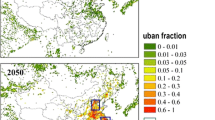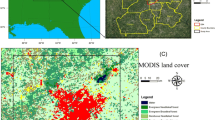Abstract
This paper addresses the contribution of urban land use change to near-surface air temperature during the summer extreme heat events of the early twenty-first century in the Beijing–Tianjin–Hebei metropolitan area. This study uses the Weather Research Forecasting model with a single urban canopy model and the newest actual urban cover datasets. The results show that urban land use characteristics that have evolved over the past ~20 years in the Beijing–Tianjin–Hebei metropolitan area have had a significant impact on the extreme temperatures occurring during extreme heat events. Simulations show that new urban development has caused an intensification and expansion of the areas experiencing extreme heat waves with an average increase in temperature of approximately 0.60 °C. This change is most obvious at night with an increase up to 0.95 °C, for which the total contribution of anthropogenic heat is 34 %. We also simulate the effects of geo-engineering strategies increasing the albedo of urban roofs, an effective way of reducing urban heat island, which can reduce the urban mean temperature by approximately 0.51 °C and counter approximately 80 % of the heat wave results from urban sprawl during the last 20 years.









Similar content being viewed by others
References
Akbari H, Levinson R, Rainer L (2005) Monitoring the energy-use effects of cool roofs on California commercial buildings. Energy Build 37(10):1007–1016
Akbari H, Matthews HD, Seto D (2012) The long-term effect of increasing the albedo of urban areas. Environ Res Lett 7(2):024004
Bornstein R (1968) Observations of the urban heat island effect in New York City. J Appl Meteorol 7(4):575–582
Cui YY, Foy B (2012) Seasonal variations of the urban heat island at the surface and the near-surface and reductions due to urban vegetation in Mexico City. J Appl Meteorol Climatol 51(5):855–868
Chen F, Kusaka H, Tewari M et al. (2004) Utilizing the coupled WRF/LSM/urban modeling system with detailed urban classification to simulate the urban heat island phenomena over the Greater Houston area. Fifth Conference on Urban Environment Vancouver BC Canada Amer.Meteor.Soc. CD-ROM 9.11
Chen F, Kusaka H, Bornstein R et al (2010) The integrated WRF/urban modelling system: development, evaluation, and applications to urban environmental problems. Int J Climatol 31:273–288
Grossman-Clarke S, Zehnder JA, Loridan T et al (2010) Contribution of land use changes to near-surface air temperatures during recent summer extreme heat events in the Phoenix metropolitan area. J Appl Meteorol Climatol 49(8):1649–1664
Hua L, Ma Z, Guo W (2008) The impact of urbanization on air temperature across China. Theor Appl Climatol 93(3):179–194
Jiang X, Wiedinmyer C, Chen F et al (2008) Predicted impacts of climate and land use change on surface ozone in the Houston, Texas, area. J Geophys Res 113(D20):D2031
Kalnay E, Cai M (2003) Impact of urbanization and land-use change on climate. Nature 423(6939):525–528
Keith DW (2001) Geoengineering. Nature 409:420
Kuang WH (2012) Evaluating impervious surface growth and its impacts on water environment in Beijing-Tianjin-Tangshan metropolitan area. J Geogr Sci (in chinese) 22(3):535–547
Kuglitsch FG, Toreti A, Xoplaki E et al (2010) Heat wave changes in the eastern Mediterranean since 1960. Geophys Res Lett 37:L04802
Kunkel KE, Changnon SA, Reinke BC (1996) The July 1995 heat wave in the Midwest: a climatic perspective and critical weather factors. Bull Amer Meteor Soc 77(7):1507–1518
Kunkel KE, Pielke RA, Changnon SA (1999) Temporal fluctuations in weather and climate extremes that cause economic and human health impacts: a review. Bull Amer Meteor Soc 80:1077–1098
Kusaka H, Kondo H, Kikegawa Y et al (2001) A simple single-layer urban canopy model for atmospheric models: comparison with multi-layer and slab models. Boundary-Layer Meteorol 101(3): 329–358
Li Q, Li W, Si P et al (2010) Assessment of surface air warming in northeast China, with emphasis on the impacts of urbanization. Theor Appl Climatol 99(3):469–478
Liu JY, Tian HQ, Liu ML et al (2005) China’s changing landscape during the 1990 s: large-scale land transformations estimated with satellite data. Geophys Res Lett 32:L02405
Liu JY, Zhang ZX, Xu XL et al (2009) Spatial patterns and driving forces of land use change in China in the early 21st century. Acta Geogr Sinica (in Chinese) 64(12):1411–1420
Liu M, Tian H (2010) China's land cover and land use change from 1700 to 2005: estimations from high-resolution satellite data and historical archives. Global Biogeochem Cycles 24(3):GB3003
Loughner CP, Allen DJ, Zhang DL et al (2012) Roles of urban tree canopy and buildings in urban heat island effects: parameterization and preliminary results. J Appl Meteorol Climatol 51(10):1775–1793. doi:10.1175/JAMC-D-11-0228.1
Miao SG, Chen F, Li Q et al (2011) Impacts of urban processes and urbanization on summer precipitation: a case study of heavy rainfall in Beijing on 1 August 2006. J Appl Meteorol Climatol 50(4):806–825
Miao SG, Chen F, Lemone MA et al (2009) An observational and modeling study of characteristics of urban heat island and boundary layer structures in Beijing. J Appl Meteorol Clim 48(3):484–501
Mölders N, Olson MA (2004) Impact of urban effects on precipitation in high latitudes. J Hydrometeorol 5(3):409–429
Oke T (1973) City size and the urban heat island. Atmos Environ 7(8):769–779
Oleson K, Bonan G, Feddema J (2010) Effects of white roofs on urban temperature in a global climate model. Geophys Res Lett 37:L03701
Patz JA, Campbell-Lendrum D, Holloway T et al (2005) Impact of regional climate change on human health. Nature 438(7066):310–317
Portman DA (1993) Identifying and correcting urban bias in regional time series: surface temperature in China’s northern plains. J Climate 6:2298–2308
Ren GY, Zhou Y, Chu Z et al (2008) Urbanization effects on observed surface air temperature trends in North China. J Climate 21(6):1333–1348
Sen Roy S, Yuan F (2009) Trends in extreme temperatures in relation to urbanization in the Twin Cities Metropolitan Area, Minnesota. J Appl Meteorol Clim 48(3):669–679
Skamarock WC, Klemp JB, Dudhia J et al. (2008) A description of the advanced research WRF version 3 NCAR Technical Note NCAR/TN–475+STR. Boulder, Colorado
Smith KR, Roebber PJ (2011) Green roof mitigation potential for a proxy future climate scenario in Chicago, Illinois. J Appl Meteorol Climatol 50(3):507–522
The Royal Society (2009) Geoengineering the climate: science, governance and uncertainty. The Royal Society, London
Xie Z, Cao HX (1996) Asymmetric changes in maximum and minimum temperature in Beijing. Theor Appl Climatol 55(1):151–156
Xu Y, Gao XJ, Shen Y et al (2009) A daily temperature dataset over China and its application in validating a RCM simulation. Adv Atmos Sci 26(4):763–772
Yan Z, Jones P, Davies T et al (2002) Trends of extreme temperatures in Europe and China based on daily observations. Clim Chang 53(1):355–392
Yan Z, Li Z (2010) Effects of site change and urbanisation in the Beijing temperature series 1977–2006. Int J Climatol 30(8):1226–1234
Zhang CL, Chen F, Miao SG et al (2009) Impacts of urban expansion and future green planting on summer precipitation in the Beijing metropolitan area. J Geophys Res 114(D2):D02116
Zhang N, Zhu LF, Zhu Y (2011) Urban heat island and boundary layer structures under hot weather synoptic conditions: a case study of Suzhou City, China. Adv Atmos Sci 28(4):855–865
Acknowledgments
This research is sponsored by the major state basic research development program of China (973 Program, no. 2010CB950900).
Author information
Authors and Affiliations
Corresponding author
Rights and permissions
About this article
Cite this article
Wang, M., Yan, X., Liu, J. et al. The contribution of urbanization to recent extreme heat events and a potential mitigation strategy in the Beijing–Tianjin–Hebei metropolitan area. Theor Appl Climatol 114, 407–416 (2013). https://doi.org/10.1007/s00704-013-0852-x
Received:
Accepted:
Published:
Issue Date:
DOI: https://doi.org/10.1007/s00704-013-0852-x




